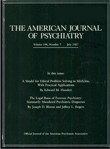Attachment Disorders in Infancy and Early Childhood: A Preliminary Investigation of Diagnostic Criteria
Abstract
OBJECTIVE: The primary purpose of this study was to compare the reliability of differing sets of criteria for attachment disorders by using a retrospective case review. METHOD: Forty-eight consecutive clinical case summaries from an infant behavior clinic were reviewed by four experienced clinicians. Attachment disorders were coded as present or absent by using competing criteria and were scored by using a continuous scale of relationship functioning. RESULTS: The reliability of alternative criteria was acceptable, but the reliability of DSM-IV criteria in diagnosing attachment disorders was marginal. Preliminary validity for the criteria was demonstrated by the fact that more severe relationship disturbances were seen in infants diagnosed with attachment disorders than in infants diagnosed with other disorders. CONCLUSIONS: Standardized assessments of at-risk populations should be used to replicate these preliminary results; revision of DSM-IV criteria may be necessary to obtain adequate reliability for diagnosing attachment disorders. (Am J Psychiatry 1998; 155:295–297)



